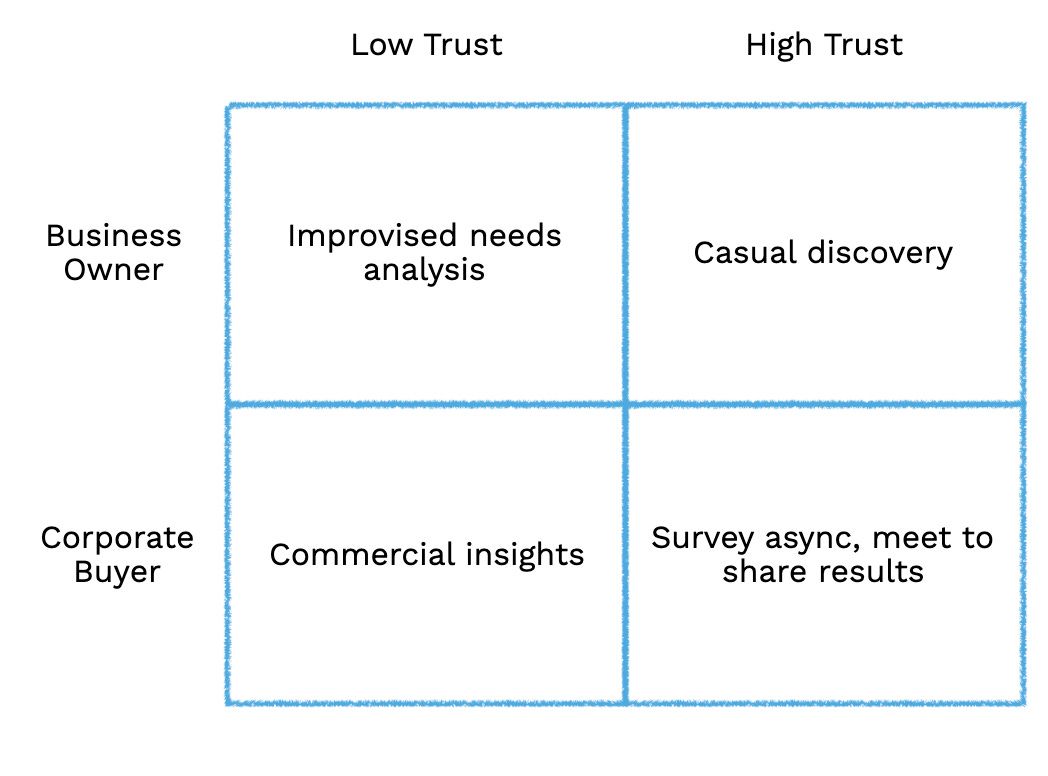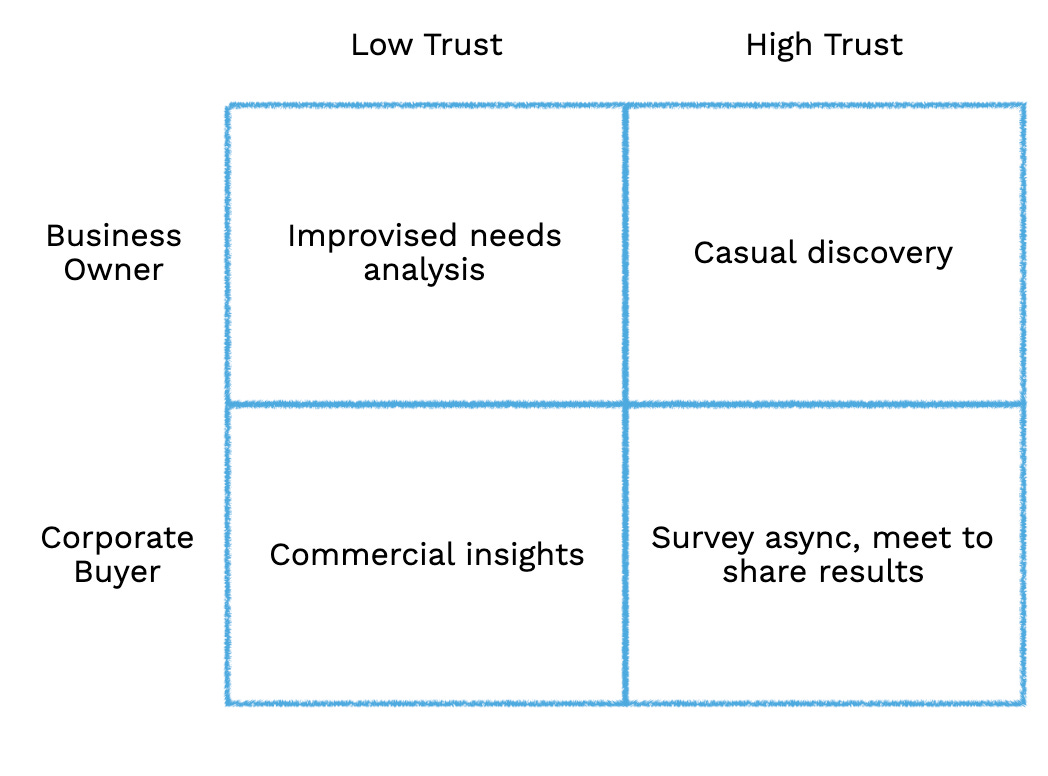How to sell without selling
or how to become a 10x salesperson without really trying

I’ll never forget my first interview to work in sales.
I pull up to the nondescript corporate building in Cupertino. I pull in to the parking spot, and turn off the engine.
Then I sit there.
One minute passes.
Five minutes pass.
I’m thinking about the life I might have, burning through phone lines to interrupt people’s days and sell them something they don’t want. The relentless push for more tiny attacks on the autonomy of others. The memorization of scripts I don’t agree with. The industrial conformity to deliver numbers I cannot control.
Ten minutes in, I finally get up the courage to act. I turn the car on and leave.
It would be three years before I realized my error.
My 23 year old self conflated mediocre salespeople with all salespeople. I had an abundance of experience with mediocre salespeople, and no experience with the best.
It turns out great salespeople are great humans. Great salespeople succeed by listening, by empathizing, by solving problems. Great salespeople succeed by bringing their whole selves to work, not just a tiny specialization in one widget or skill. Like developers, they often have a broad toolkit to bring to new problems.
Great salespeople, like great developers, are also 10x more productive. This is because the speed limit on salespeople, like developers, is often unlimited. A 10x developer can create the MVP for a unicorn in a weekend; a 10x salesperson can presell a years worth of quota in a month.
If you want to do interesting things in business, at least in B2B, it helps a lot to strive to become a 10x developer or a 10x salesperson.
Here’s a secret: if you are slightly above average in development and sales, you can quickly become 10x at both.
The best salesperson has to be so good at selling, they can achieve their targets without changing the product.
The best developer has to be so good at making products, they can make the wrong thing a dozen times, all to avoid talking directly to a customer.
Give a salesperson the power to make the product, and they become better at sales.
Give a developer the emotional intelligence to listen to customers and make what they want, and they become better at making what people will buy.
This doesn’t scale; eventually the maker can’t sell to everyone, and the developer can’t talk to everyone. But it makes for a fast start.
I’ve alternated between learning sales and product development for the past few years, and an interesting recent trend in product is the nocode movement. Tools like Bubble and Webflow, created in 2015, are no hitting a threshold of quality that rivals traditional approaches to programming. Someone sufficiently motivated can now build an app without coding.
I want to share today the sales counterpart: how to sell without selling.
The short version:
- Establish trust
- Establish status
- Share competency based on your position of status and trust
Here’s your 2x2:

Establish Trust
Good marketing works because it increases trust with your buyer, and the best salespeople can establish trust with anyone.
In general, outbound sales are low trust, and inbound sales are high trust. Referrals are the highest trust of all.
If you don’t have the time for marketing, nor the EQ for trust, the quick hack is to simply be aware of how much trust you have. If you’re anything like me, you’ll learn this by often assuming too much trust, and then getting rejected, until you notice it.
Establish Status
Status underpins selling. Keith Johnstone, author of the book Impro (and a gonzo blog), explains this as well as anything I’ve found.
The best salespeople establish nearly equal status with their buyer. Ideally, you match status so closely that the buyer sees you as a peer.
Most of us prefer to play high status or low status. If you can only play one status range, you’ll only be able to sell to people who match this by accident.
I’m fairly awful at status games, and overall I don’t enjoy them, so I find it enough to notice the status of those around me and try to choose situations where the ambient status matches my own.
Many sales strategies essentially boil down to “sell to your status.” When a sales leader insists you call up to the executives, it is likely because they are good at playing high status; they thrive talking to executives with the same status. When a book describes how to sell to a committee, the author probably feels more comfortable with the status games in a committee.
The most important thing for status is to simply know the status of your buyers, on average.
Share competency
With a sense of status and trust, you can share competency. This is where it gets interesting, where you sell without selling.
If you sell to a business owner, they usually have low status.
“What do you mean, low status? How can the owner have low status?”
Most business owners play games of wealth, rather than games of status. So although they have a structural high status within the context of their company, they have low status in the context of talking to an expert that can bring them more wealth.
Compare this to a typical corporate buyer: they have almost zero leverage in wealth creation, so most of their work is in status creation. Every day, they navigate a work environment where their status with peers, colleagues, rivals all can change. The upside of a great purchase is more likely a bump in their status than any change in their wealth.
Some business owners are really just corporate buyers, but the majority of them look like the owner of a nail salon, working 16 hour days in the hope that they can sell their company when they retire.
That’s not a status play.
If you’re great at sales, you can manage the trust and status available to you in any situation. For the rest of us mere mortals, it is enough to simply measure the trust and status, and share the appropriate competency.
Corporate buyer, low trust
This is the worst position to be in, but not all hope is lost. In the book Challenger Sale, CEB outlines a method to sell in this environment. In short: by sharing high quality commercial insights, you can establish trust and status with the corporate buyer. The commercial insights work because they can make the buyer look good, nudge them toward a focus on wealth over status, and establish trust with your company.
In general, commercial insights are highly refined refactor of how your target buyer achieves their goals, backed by research every level of their company will respect.
Commercial insights are scarce, except by accident, so you should avoid producing them unless you have an accidental abundance.
The Challenger Sale works for a corporation like Xerox selling printers to school districts: with a large enough sales force, you can even justify a $1M research project to get great commercial insights, because it is cheaper than building a new $10M product.
Corporate buyer, high trust
If the corporate buyer has high trust with you, you can make a half baked version of commercial insights and get the same results. Essentially, you can survey their external stakeholders and share the results of the survey.
- Selling to marketing? Interview their prospects and share the videos
- Selling to HR? Interview ten top candidates for a job and share their feedback
- Selling to Finance? Benchmark their budgets against the industry
In general, corporate buyers don’t interface with their market beyond their coworkers, so you can establish competency by simply doing this for them.
The amount of trust needed to run this plan, vs the commercial insights, is a matter of pattern recognition. In general, if you know the buyer’s external stakeholders better than they do, you can run this play first. If you don’t know them, the commercial insights is probably what you eventually need anyway.
Business owner, low trust
With corporate buyers, you often need to lead with tangible credible research that breaks their normal status games. Done right, you bypass all RFPs and corporate buying patterns, because you are the only provider who can solve their unique problems.
With business owners, it is easier. Hilariously so.
I know of multiple entrepreneurs who started their companies by cold calling business owners, figuring out what they needed, and pre-selling them on a mockup.
I call this improvised needs analysis: it starts out looking like customer discovery, but you apply the principles of improv to get deeper into the customer’s challenges.
Nearly every business owner has a list of core challenges, and no one around who cares. Absent a sounding board to work through these challenges, they rarely take the time to dig deeper and find the root causes of their problems.
So simply talking to them about their needs, and digging deeper to find the real challenges, will often get you to the natural point of a sale.
Business owner, high trust
The ideal situation, if your personality is anything like mine, is a business owner with high trust.
I’ll never forget the client I stumbled upon in Thailand. December 2013, I’m scanning my LinkedIn views, and I see that a CEO in Bangkok looked at my profile. I was thrilled! At that moment, I was the business owner with no peers, desperate for a sounding board, and I was going to be in Bangkok in ten days. I quickly wrote him a message, hoping we could get dinner, and I could learn more about how he started his company in a foreign country.
Dinner arrived, and two hours later he’s asking me how we can work together. All I did was ask him questions about his business, and dig deeper to understand for my own benefit, and now he wanted to pay me!
When you meet a business owner, and you have enough trust, you can do away with much of the formalities. Simply having a casual conversation that uncovers their needs can be mutually interesting, and lead to a sale.
In each of these scenarios, you can succeed at selling by offering minimum viable competency appropriate to the situation.
Corporate buyer, low trust? Bludgeon them with a commercial insight so profound they have no fear of selling it to the board three levels above them.
Corporate buyer, high trust? Just do the leg work they won’t do, talk to their external stakeholders, and share the results.
Business owner, low trust? If you can get their attention, and you demonstrate conspicuous curiosity during an interview, you can become an expert in their business problems and be on your way to solving them.
Business owner, high trust? Just get dinner.